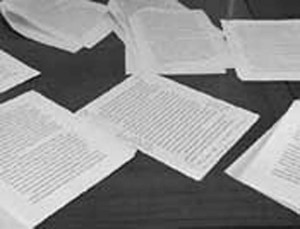I have a penchant for mixing things up in class, if only to keep writers on their toes. For many semesters, I got away from any writing on paper in favor of blogs, digital stories, and wikis. Now, in a literature course I last taught as paperless, some old friends (and nemeses) have returned: staples, margins, page numbers.
Why have I returned to the 20th Century?
When conducting a “paper chase” with 16 Writing Consultants and 18 literature students, I found that paper enables my Consultants to write the sort of commentary they will most likely write for our professors or in our Writing Center. In time, our faculty will embrace multimedia for many projects, but even then, Writing Consultants will need to understand the rhetoric of linear as well as associative, collaborative projects.
One could do what I’m doing with file exchanges, of course, and some faculty do just that. I’m no stranger to MS Word’s track changes and embedded comments, but even as I write this post, a student has contacted me with a question: the introduction I returned to her, with my comments linked to text, does not seem to be “working.”
I’m not fond of MS Word’s dependence upon co-writers having similar versions. I’ll probably have to switch to Google Docs to finish helping her. It’s simply a simpler, and more ubiquitous, technology. Yet even that lacks the ubiquity of paper.
Paper cannot show multimedia (yet). Paper cannot have live feedback forms or allow online tagging and collaboration (yet). Despite these limitations, I’m most curious to see how a paper-based class goes for me this term. Stay tuned.
Some tasks are, however, inefficient on paper. I’d include sign-up sheets for Writing Consultants, whether done collaboratively or with a single editor, as in this example from my current lit. class. Everyone with the link can view the document from wherever they may be. I now consider Google Docs to be “paper plus,” since they preserve what is best about linear discourse but add collaborative features that are clumsy in Microsoft Office, a technology designed for print.
